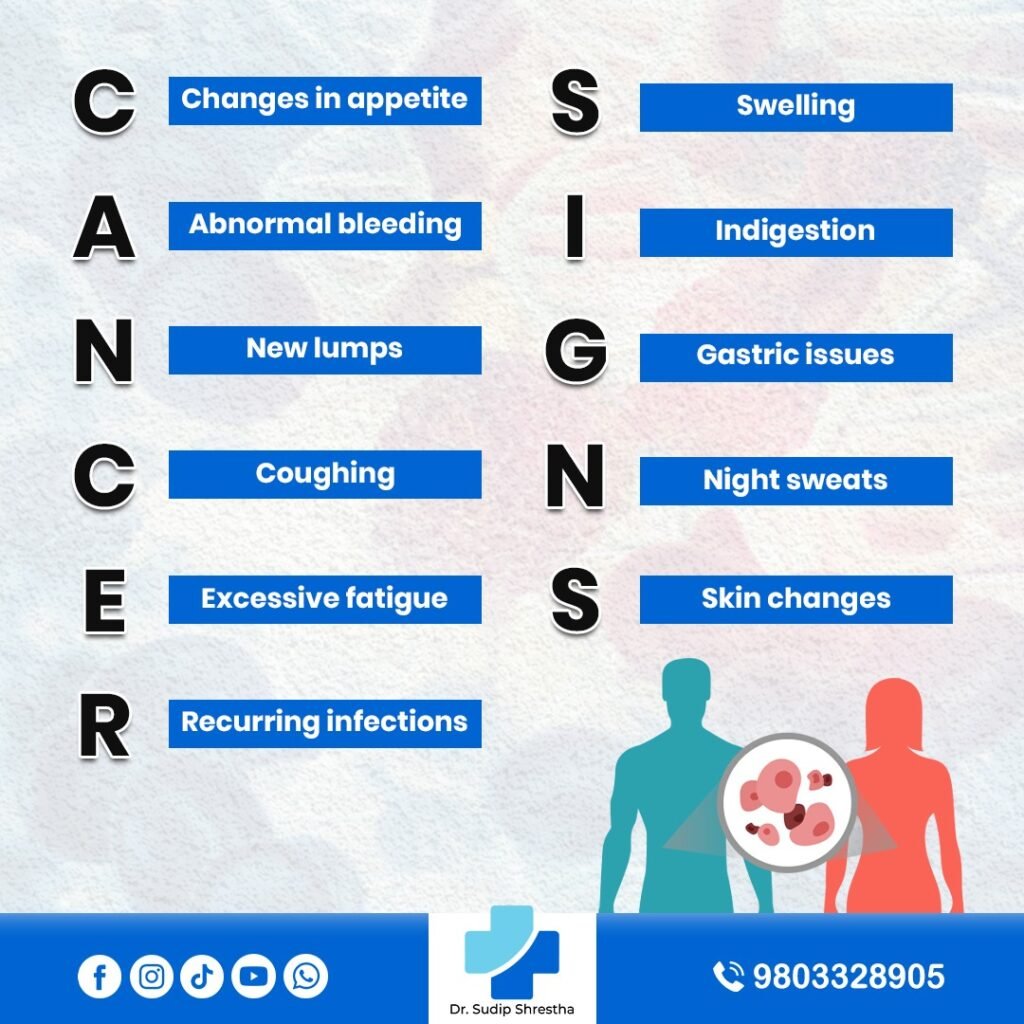Cancer is one of the leading causes of death worldwide, and yet, many cases are diagnosed in later stages when treatment options become limited. Early detection remains one of the most powerful tools in the fight against cancer. At the forefront of cancer care in Nepal, Dr. Sudip Shrestha emphasizes the importance of recognizing early warning signs and seeking medical attention promptly. In this article, we will explore some of the most common early signs of cancer and explain why you should never ignore them.
Why Early Detection Matters?
Cancer is most treatable when caught early. Detecting cancer in its initial stages can significantly improve survival rates, reduce the need for aggressive treatments, and improve quality of life. Unfortunately, many early cancer symptoms are subtle, easily overlooked, or mistaken for common ailments. Being informed can make all the difference.

1. Unexplained Changes in Appetite or Weight
A sudden loss of appetite or unexplained weight loss can be an early sign of several types of cancer, including stomach, pancreatic, and lung cancer. While it might be tempting to view unexpected weight loss as a positive change, it often signals an underlying health issue that needs medical attention.
What to watch for:
- Feeling full quickly after eating small amounts
- Ongoing nausea or vomiting
- Significant, unintentional weight loss (5 kg or more)
2. Abnormal Bleeding
Unusual bleeding is a major red flag for several cancers. For instance, rectal bleeding may indicate colorectal cancer, while abnormal vaginal bleeding could signal cervical or endometrial cancer. Coughing up blood may point to lung cancer.
Types of bleeding that warrant concern:
- Blood in urine
- Blood in stool
- Vaginal bleeding between periods or after menopause
- Persistent nosebleeds or bleeding gums
3. New or Unusual Lumps
Finding a lump in your body can be alarming, and rightly so. While not all lumps are cancerous, a painless, hard mass that continues to grow should never be ignored. Breast cancer, lymphoma, and testicular cancer commonly present with lumps.
Where lumps may appear:
- Breast
- Neck
- Underarms
- Groin
- Testicles
4. Persistent Pain
Chronic pain that doesn’t go away or has no clear cause can be an early symptom of certain cancers. For example, a headache that doesn’t respond to treatment might suggest a brain tumor, while persistent back pain could indicate bone or ovarian cancer.
Key signs:
- Pain that worsens over time
- Pain that is not relieved by usual medications
- Pain that interferes with daily life
5. Changes in Skin
Skin changes are not just related to skin cancer. Other cancers may also cause visible changes in the skin.
What to look for:
- New moles or changes in existing moles
- Jaundice (yellowing of the skin or eyes)
- Darkening, redness, or itching
6. Fatigue That Doesn’t Go Away
While everyone feels tired occasionally, cancer-related fatigue is more profound. It doesn’t improve with rest and can become debilitating.
Associated cancers:
- Leukemia
- Colon cancer
- Stomach cancer
7. Difficulty Swallowing or Persistent Indigestion
These symptoms are often associated with esophageal or stomach cancer. Persistent indigestion, bloating, or a feeling that food is stuck in your throat should be evaluated.
8. Persistent Cough or Hoarseness
A cough that lingers for more than three weeks, especially if it’s accompanied by blood or chest pain, could indicate lung or throat cancer. Persistent hoarseness can also be a symptom of thyroid or laryngeal cancer.
When to See a Doctor
Dr. Sudip Shrestha advises that if any of these symptoms last for more than two weeks, it’s time to consult a healthcare professional. While these signs may not necessarily mean cancer, early testing can rule out serious conditions and offer peace of mind.
The Role of Screening and Regular Check-Ups
Many types of cancer can be detected before symptoms appear through routine screenings. These include:
- Pap smears for cervical cancer
- Colonoscopies for colorectal cancer
- Mammograms for breast cancer
- PSA tests for prostate cancer
Dr. Shrestha and his team emphasize the importance of age-appropriate cancer screenings as part of regular health check-ups, especially for individuals with a family history of cancer.
Risk Factors to Consider
Some people are at a higher risk of developing cancer due to genetic, environmental, or lifestyle factors.
Key risk factors include:
- Smoking and tobacco use
- Heavy alcohol consumption
- Family history of cancer
- Obesity and poor diet
- Exposure to carcinogens at work or in the environment
Understanding your risk helps you make informed decisions about prevention and screening.
Prevention Is Still the Best Medicine
While not all cancers are preventable, adopting a healthy lifestyle can significantly lower your risk.
Tips from Dr. Shrestha:
- Avoid tobacco and limit alcohol
- Maintain a balanced diet rich in fruits and vegetables
- Exercise regularly
- Protect your skin from excessive sun exposure
- Get vaccinated against cancer-related viruses (e.g., HPV, Hepatitis B)
Final Thoughts
Cancer doesn’t always make a loud entrance. Sometimes, it whispers through subtle signs that are easy to ignore. By staying aware of changes in your body and seeking timely medical advice, you increase your chances of early diagnosis and successful treatment.
As a leader in oncology in Nepal, Dr. Sudip Shrestha encourages everyone to take charge of their health. Early detection saves lives and that starts with knowing what to watch for.
For more expert insights, visit Dr. Sudip Shrestha’s blog or schedule a consultation through drsudip.com.np.



